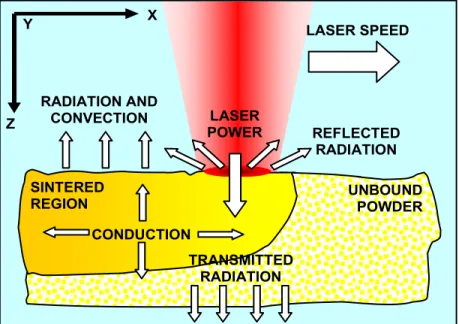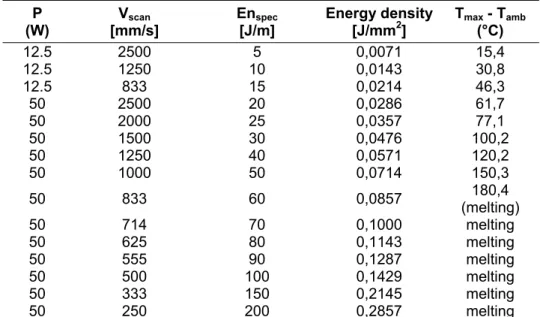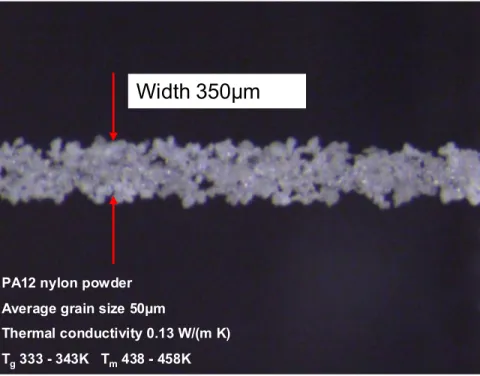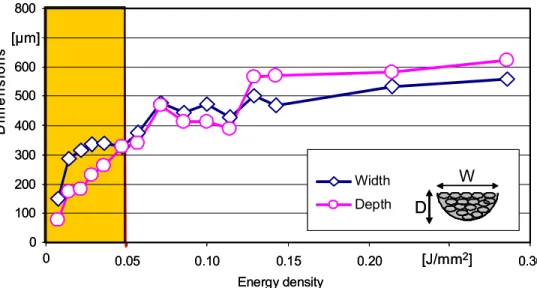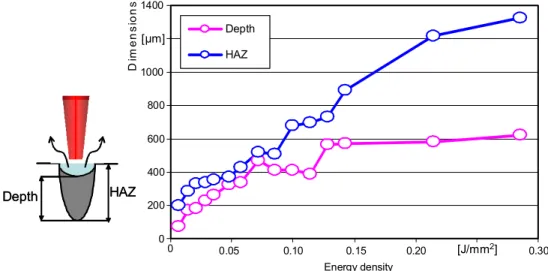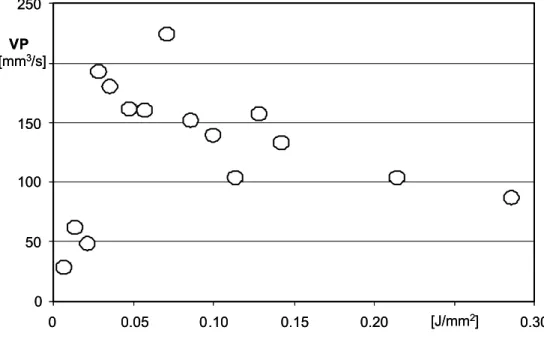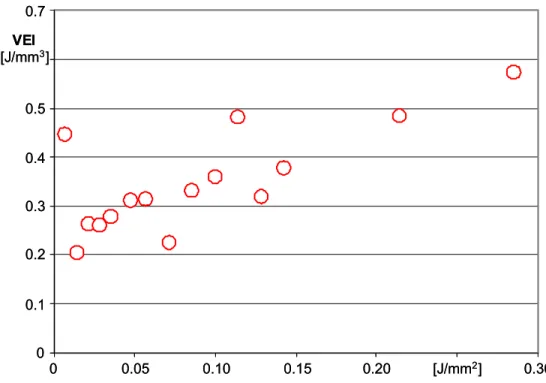6 CONTROL OF THE
SELECTIVE LASER SINTERING
OF NYLON POWDERS
This case study represents a first application of the thermal models proposed in the previous chapter. It concerns Selective Laser Sintering (SLS) which has a potential as environmental benign alternative to machining processes in terms of rapid prototyping technique.
Since only few authors deal with the process optimisation including energy aspects, this process was retained adequate to be controlled by the afore mentioned thermal models. In the present chapter an analysis of the energetic aspect of SLS is proposed. In addition to the classical technological parameters (resolution, productivity) attention is paid with to energetic consumption (energetic productivity) showing how the perspective of a sensible development of such kind of technology could be beneficial not only from a technological point of view, but also for energy saving in several manufacturing fields. A polyamide powder is the material tested to acquire some characteristics data of the process. It is shown that the energy intensity of the process in optimal condition could be of the order of 0.2 J for each mm3 of material agglomerated.
NOMENCLATURE
abs absorption coefficient
Cp specific heat J / kg K
k thermal conductivity W / m K
P power of laser beam W
q''& specific thermal power of the laser radiation W/m2 Q intensity of line heat source J/m
r cylindrical coordinate m
ref reflection coefficient
s distance traveled in the unit time mm
t time s
t* radiation incidence duration s
tr transmission coefficient
T(z) temperature in the z direction K
Tg glass transition temperature K
To initial temperature of the powder bed K VP volumetric productivity mm3/s VEI volumetric energy intensity J/mm3
v scanning speed mm/s
z coordinate in the direction of the laser beam mm α thermal diffusivity (= k / ρ Cp) m2 / s
Ø spot diameter of laser beam µm
ρ density kg/m3
6.1 INTRODUCTION
The purpose of manufacturing processes is to transform materials into useful products. In the course of these operations, energy resources are consumed. Much of the work characterizing environmental impacts of manufacturing processes and systems has focused on energy consumption patterns. From the analysis of the literature it is apparent that energy and electricity use per unit of material processed has increased over the past decades. Energy consumption is a component of environmental impact and it is a critical component in any overall sustainability strategy [1].
Selective Laser Sintering (SLS) is a layered manufacturing (LM) or rapid prototyping/manufacturing/tooling (RP/RM/RT) technology [2] for powder materials like polymers, metals, ceramics and composites.
In the SLS process 3D computer images are sectioned into thin 2D layers (0.05– 0.3 mm in thickness) and the 3D object are built layer by layer by laser-induced fusion (usually CO2) of small particles of materials that are agglomerated together. The advantage of SLS is not only to reduce the time and cost of prototyping components obtaining dimensional accuracy, surface finish and repeatability similar to common manufacturing process, but also on reducing the energy intensity and environmental impacts of the process. SLS of materials deposited by dozens or hundred of micro-nozzles according to a pattern embodied within a 3-D form may be more energy intensive of conventional fabrication technologies.
Even though polymer is the most processed type of material in SLS, the consolidation phenomena invoked for polymers are probably still amongst the least understood or at least the least described in literature. This explains why commercial applications of SLS today are limited to a small number of polymers: mainly polyamide (PA 12 and PA 11), polycarbonate (PC), polystyrene (PS) and variants of those [3]. Polymers are characterised by quite low sintering temperature (< 200 °C) and thermal conductivity (below 1 W/m K) so they can be considered as insulating materials. Polymer based powders have a peculiar behaviour with respect to a heat transfer dominated process like SLS, differently from metal based powders, characterised by thermal conductivity and thermal diffusivity of one or two orders of magnitude higher. This method of fabrication is characterized by a deep interaction between heat, mass and momentum transfer as well as on chemical modifications of the materials and on variation of mechanical and thermophysical properties of materials. This interaction makes the analysis of the process very complex. For this reason the application of the method is often based on empirical and technological experience. One of the main problems concerned with the application of the SLS technology is the optimal parameters selection. For a given kind of powder materials (it corresponds to define thermophysical properties like density, specific heat, thermal conductivity, glass transition and melting temperature and other properties, such as granulometry and average grain dimension), the main technological parameters to control the SLS process are: - the scan spacing;
- the laser beam power; - the laser spot diameter; - the scan speed.
A model of the process can be important to understand how the various process variables (parameters) affect the sintering mechanisms in order to select appropriate parameters values before processing and to provide guidelines for optimization of the process both on technological and energetic point of view. Several papers are available in the literature that considers the process of Selective Laser Sintering from the perspective of modelling.
An energy balance model for polyamide [4] and an analytical model for polycarbonate have been proposed in [5] and [6]. Three strategies have been investigated: analytical, adaptive mesh finite difference and fixed mesh finite element, with more layers. The aim of the simulation was to predict the sintering depth/width as a function of the process parameters. The authors proposed a one-dimensional analytical model [7] and a 3D numerical model [8] of the SLS process of pre-coated sands for shell-moulding. In [9] a purely experimental (DOE) approach is used to evaluate the mechanical resistance of a polymer composite as a function of the Energy density. While [10] optimises the SLS parameters to build polyester lattice structures. Also experimentally, [11] and [12] examine the effect of preheating and respectively of part porosity and post processing on the mechanical properties of polyether and polycarbonate. Although complex and unpractical, two- and three-dimensional analytical models still show severe limitations for direct quantitative predictions. Numerical models still require a deep understanding of the most involved phenomena and have the drawback that the materials thermo-physical properties and the actual input energy need to be characterised with
special tests and methods [13, 14], which are critical issues. On the other end, purely experimental (statistical) approaches are necessarily specific, they are not able to seize the phenomenal aspects and they may turn out inefficient. Only a few optimisation examples are available in the literature, particularly in the case of polymer based powder beds. RP techniques were conceived for time compression. With growing energy constraints, SLS has the potential of saving direct and indirect materials, energy, emissions, money etc. compared to conventional processes [15]. Only few examples of energy consumption and other environmental impact parameters for different RP processes [16] and showing the advantage of laser based metal deposition versus conventional processes [17] are available in the literature. Manufacturing is directly connected to natural resources and energy use. This dependence results in a necessity to reduce, with increasing product output, the amount of employed resources and thereby increase resource productivity and energy requirements.
The aim of this work is to develop and enhance the knowledge regarding the energetic aspect of SLS. With this work we would like to analyse SLS process from the point of view of a combined indication of productivity and energy aspects and s simple process modelling for preliminary parameter estimation. In addition we will point out which thermophysical properties, such as the thermal conductivity and diffusivity, represent key parameters in the SLS of polymers and for the interpretation of scattered experimental data and we want to understand if modelling of the process using simplified approaches can be useful to obtain some preliminary information on the energy requirements of the process.
6.2 MODELLING OF THE SLS PROCESS
SLS is characterised by a deep interaction between heat, mass and momentum transfer along with chemical transitions and variations of the mechanical and thermophysical materials properties.
As stated in the previous chapter, processing with IR lasers can be retained a pure thermal process. As first approximation it will be then assumed that the SLS of polymer based powders is dominated by heat transfer and models will recall the following hypotheses already mentioned in the study of thermal conduction in laser processing of polymers.
1. A complete thermal model should include the terms shown in figure 1, but convection and radiation at the boundary are negligible because of the low exchange surface and temperature.
2. Sintering is observed mostly when the radiating energy is acting [7].
3. The variations of the thermo-physical material properties, particularly of the thermal conductivity and of the specific heat, are averaged in the observed temperature range.
4. The material is considered continuous and homogenous with isotropic thermal conductivity.
5. Local phenomena related to chemical reactions that could be important are not considered.
As stated before, the mathematical description involves the solution of the unsteady heat conduction equation. The model reproduces the thermal history within the powder bed after the radiation incidence starts.
Analytical solutions that can be useful for the calculation of the transient temperature and of the heat transfer of objects irradiated by a power input were proposed in the previous chapter.
SINTERED REGION LASER SPEED LASER POWER TRANSMITTED RADIATION REFLECTED RADIATION RADIATION AND CONVECTION CONDUCTION X Z Y UNBOUND POWDER
Figure 1 - The main energy terms in SLS.
As stated in the previous chapter not the total amount of energy input is available for the sintering process: when the laser spot hits the powder, the surface interaction with the radiant energy can be described by the coefficients representing the fraction of absorbed, reflected, and transmitted energy (figure 1). The three coefficients depend on the powder used. For nylon powder, the absorptivity coefficient is
abs ≈0.9 (1).
As mentioned before, the penetration of the glass-transition temperature front into the powder bed determines the depth and width of the heat-affected zone (HAZ). However this thermal problem, even if conceptually simple, has not a simple solution for the following reasons:
- the intrinsic complexity of the phenomenon and of its mathematical modelling (three-dimensional thermal conduction with convective surface heat dissipation); - the difficulties in the characterisation of the material from a thermo-physical point of view (thermal conductivity, specific heat capacity and thermal diffusivity);
- the difficulties in a correct modelling of the material from a chemical point of view (polymerisation temperature, energy released during the polymerisation process caused by the breakage of chemical links, melting, etc.).
Moreover it would be necessary to consider the following aspects that are usually neglected in the modelling:
- the influence of mechanical phenomena, like the powder agglomeration caused by friction and by special thermo-hygrometric conditions;
- the effects of the non-homogeneous material;
- the changes of the thermo-physical properties of the material with the temperature.
Many authors dealing with polymers [4] [5] [6] make use of the unsteady model of the moving point source: the heat transfer in a plane perpendicular to the laser axis is neglected and the heat transfer, dominated by conduction, is only studied in the laser beam direction (z in figure 1). The phenomenon is governed by the well known one-dimensional heat conduction equation, with the symbols and values in Table 1: 2 2 p T(z, t) k T(z, t) t c z ∂ ∂ = ⋅ ∂ ρ ⋅ ∂ (2)
with the following boundary conditions:
z 0
T
-k
q''
0 t t*
z
=∂
=
≤ ≤
∂
&
(3a)( )
o T 0,0 =T (3b)q''& [W/m2] is the specific thermal power of the laser radiation determined by P/(Ø.s), being P and Ø the power and the spot diameter of laser beam, s the distance travelled by the laser in the unit of time at scanning speed v, T0 the initial temperature of the powder bed and t* the radiation incidence duration that can be estimated by
t* = (Ø / v) (4).
The temperature rise during the radiation incidence can be expressed analytically for a rectangular surface circumscribing the laser spot, as already described in the previous chapter.
With polymer based powders, thermal sintering occurs already at a temperature lower than the melting point Tm: at the glass transition temperature Tg, agglomeration among grains is dominated by polymer chain rearrangement and cross-linking. The sintered material is included inside the envelope of the Tg reached by the powder, where agglomeration is activated. Using the model of linear heat conduction is then possible to derive the sintered depth z along with the layer thickness obtainable in a single pass.
Equation (5) can be used to estimate the history of the maximum temperature, which occurs on the surface (z=0) and should be kept below the polymer melting or degradation temperature in order to increase the efficiency of the process in terms of volumetric productivity.
o
2q ''
t
T(0, t) T
k
α
−
=
⋅
π
(5)Even if the point heat source model is the more commonly used in the literature, as in [5] [6], it is not suitable for the analysis of thermal conduction in the lateral direction and it makes difficult to evaluate the radiation incidence duration for high scanning speeds used in case of laser sintering (over 2m/s).
For these reason the sintering process has been analyzed with the instantaneous line heat source model (intensity Q [J/m]). This 1.5-dimensional model with a radial heat flow along the cylindrical coordinate r with respect to the ideal axis gives an idea of the sintered width which is supposed to be double than r. The temperature increase around the line heat source:
2 o Q r T(r, t) T exp 4 kt 4 t ⎡ ⎤ − = ⎢− ⎥ π ⎢⎣ α ⎥⎦ (6)
This model shows a direct connection between Q and the Energy density, expressed in [J/mm2], defined as
ED P V Ø =
⋅ (7)
a parameter commonly used in the literature [4] [5] [6] [9] [11] to express the SLS process parameters in energetic terms. From the analysis of the literature and applying some of the models analyzed it could be interesting to carry on evaluations on the energy aspects of the process even if in the great part of technological applications the analysis is complicated by the presence of preheating phase.
6.3 EXPERIMENTAL ANALYSIS
The processes selected is the SLS by a CO2 laser with Gaussian TEM, of a polyamide powder (Nylon® PA 12 from EOS company), a typical RP application. Table 1 lists the main properties of nylon powder required by the models in paragraph 2.
It can be noticed that the nylon powder have been selected because of its thermal properties (thermal conductivity and diffusivity), which represents the typical range of thermoplastics used for rapid prototyping. Moreover the almost spherical grain shape and the average size distribution are quite uniform thus allowing an easier analysis of the agglomeration process.
Experiments have been carried out using an experimental prototyping machine which makes use of a 10.64µm laser source in pulsed regime (100µs pulses at 5kHz frequency) of maximum average power of 50W. The beam was deflected on the working surface by a mirror-equipped head at maximum speed of 2.5m/s.
The nylon powder is deposed on a container by an automatic charging hopper which also regulates the layer to a thickness of around 1mm.
The range of energy density, defined with equation (7), used in experiments, has been preliminarily estimated by the models in paragraph 2 and turned out to be comparable to those used in [5] and [6]. ED has been varied modulating the scanning speed and the laser power in the range respectively of 500-2500 mm/s and 12.5-50 W. The laser spot diameter Ø was constant and kept to the minimum achievable with the experimental setup: 700µm. At the beginning of each experiment, the powder bed was kept at room temperature (20 °C). A combination of 16 different group of parameters have been tested, covering a wide range of energy density between 0.0071 and 0.2857 J/mm2 as shown in Table 2.
name unit value
ρ density (non pressed) kg/m3 840
- apparent density % 75
- average grain size mm 0.05
cp specific heat kJ/(kg K) 2.5
α thermal diffusivity (k / ρ cp) m2/s 6.1.10-8
k thermal conductivity W/(m K) 0.13
Tg glass transition temperature K 333-343
Tm melting temperature K 438-458
Table 1 - Properties of the tested nylon powder [13]. P
(W) [mm/s] Vscan En[J/m] spec Energy density[J/mm2] Tmax(°C) - Tamb
12.5 2500 5 0,0071 15,4 12.5 1250 10 0,0143 30,8 12.5 833 15 0,0214 46,3 50 2500 20 0,0286 61,7 50 2000 25 0,0357 77,1 50 1500 30 0,0476 100,2 50 1250 40 0,0571 120,2 50 1000 50 0,0714 150,3 50 833 60 0,0857 (melting) 180,4 50 714 70 0,1000 melting 50 625 80 0,1143 melting 50 555 90 0,1287 melting 50 500 100 0,1429 melting 50 333 150 0,2145 melting 50 250 200 0,2857 melting
Table 2 - Experimental tests and theoretical evaluation of maximum surface temperature increase obtainable with: wavelength 10.64µm, pulse duration 200µs, spot diameter 700µm, frequency 5kHz.
The evaluation of the temperature obtained by means of equations (5) and (6), as appear in the table, suggests that at a value of energy density of about 0.08 J/mm2 local melting on the surface could be expected.
Figure 2 – Draft of the extraction procedure of the sintered lines.
Linear scans of 80mm length on the powder bed produced basic sintered structures (reported in figure 2) which were separated from the non-sintered polymer emptying the powder container from a bottom hole, has shown in the second step of figure 2. Before starting this procedure the sintered lines were glued by a single drop of acrylic resin to the supporting parts of the container, thus avoiding displacements or misalignments.
Figure 3 – Top view of a sintered line and measure of the averaged width. Process parameters: wavelength 10.64µm, pulse duration 200µs, spot dimensions 700µm, frequency 5kHz, scanning speed 2.5m/s, average power 50W.
LASER SINTERED LINES POWDER CONTAINER ACRYLIC GLUE DROP EXIT HOLES VIBRATING PLATE LASER SINTERED LINES POWDER CONTAINER ACRYLIC GLUE DROP EXIT HOLES VIBRATING PLATE LASER SINTERED LINES POWDER CONTAINER ACRYLIC GLUE DROP EXIT HOLES VIBRATING PLATE
Width 350µm
Width 350µm
PA12 nylon powder Average grain size 50µm
Thermal conductivity 0.13 W/(m K) Tg333 - 343K Tm438 - 458K
As final step, non-sintered grains which can be affect the measuring process were removed positioning the container for 1 minute on a vibrating plate (frequency 1400Hz, amplitude 10µm). In this way powder grains linked to the structure by friction or by secondary hygrometric conditions can be easily eliminated maintaining the integrity of the structure.
The container was then placed under an optical microscope (resolution 50µm): with reference to figure 1, depth and width of the sintered lines were measured along the z axis (depth) and the y axis (width). An example is given figure 3 which shows the remarkable uncertainties in determining the contour which defines the sintered profile. For this reason, line structures were measured in 5 different points (including the highest and the lowest value) and data were averaged to obtained mean values for width and depth.
The averaged line depth is directly related to the thickness of a layer obtained by using a predetermined energy density. On the other hand the averaged width represents the limit value for the scan spacing parameter, to be used at a certain energy density, in order to guarantee a correct overlap between adjacent sintered lines.
6.4 EXPERIMENTAL RESULTS
In the present paragraph the results of the experimental investigation carried out are exposed and briefly discussed. Each testing condition in figures 4 to 7 is represented by the average values obtained by the afore mentioned 5 different measurements. Figure 4 contains the dimension of the lines obtained as a function of energy density. From Figure 4 it can be noticed that width and depth of line scans increase with the energy density.
Figure 4 – Depth and width of sintered lines depending on energy density adopted. For low values of the ED (0.02-0.03 J/mm2), depth is about half of width, corresponding to the cylindrical distribution of isothermal surfaces, as can be predicted by the instantaneous line heat source model in equation (6). For nylon,
[J/mm2] 0 100 200 300 400 500 600 800 0 0.05 0.10 0.15 0.20 0.30 Energy density Di m e n s io n s Width Depth W D [µm] [J/mm2] 0 100 200 300 400 500 600 800 0 0.05 0.10 0.15 0.20 0.30 Energy density Di m e n s io n s Width Depth W D Width Depth W D W D [µm]
width is predominant onto depth up to energy density of about 0.10 J/mm2, reaching a limit value of about 0.5 mm which depends on the laser spot diameter. This can be explained by its low conductivity and diffusivity that keep heat localised in the irradiated area.
Depth increases almost linearly, more than width, because of the preferential heat diffusion along axis z, according to the point heat source model, until the reach of an asymptotic limit. The linear trends of figure 4 are upper limited by thermal constraints, suggested by the exponential nature of the point heat source model in the previous chapter.
Figure 5 – Depth and HAZ of sintered lines depending on energy density adopted. Figure 5 analyzes the difference between the depth of the layer agglomerated and the thickness of the heat affected zone (HAZ). With the diction heat affected zone the distance between the more distanced grains. From the figure it can be observed that for a quite low value of energy density the HAZ zone and the agglomerated dimension are quite similar. For values higher than 0.10 J/mm2 the difference between the two dimensions was found to be remarkable. This means that a meaningful melting or even a vaporization process is occurring on the surface grains due to the additional energy input. For this reason while HAZ linearly increases with ED the effective depth f the sintered lines reaches a limit value which reflects the balance between further conduction along z and vaporization on the surface.
In figure 6, the Volumetric Productivity (VP), obtained as the product of scanning speed by width and depth in figure 4, is plotted as a function of the energy density. Finally figure 7 provides the Volumetric Energy Intensity (VEI), obtained as the laser power divided by the volumetric productivity in figure 6 and expresses the agglomeration efficiency of laser power.
Similarly to [16] VEI can be considered as an indicator of the specific energy consumption of the process. In optimal conditions VP should be maximised and the VEI should be minimised. Values ranging around 250 mm3/s probably represent an absolute maximum of the VP for nylon PA12. In the range 0.06-0.08 J/mm2 both
0 200 400 600 800 1000 1400 Depth HAZ Depth HAZ [J/mm2] 0 0.05 0.10 0.15 0.20 0.30 Energy density HAZ Depth HAZ Depth D im e ns io ns [µm]
productivity and energy intensity are optimal for nylon and are close to those pointed out by other researchers [6]. In this range the process resolution is also good.
Figure 6 – Volumetric Productivity depending on energy density adopted. In the optimal conditions, productivity and agglomeration efficiency can be increased up to 100% in the examined range of the SLS parameters. The Volumetric Energy Intensity of the examined processes is one order of magnitude lower than conventional processes discussed in [16].
Figures 6 and 7 show that different optimisation criteria can be satisfied with similar process parameters, particularly in the case of nylon. These optimal conditions have been achieved without preheating. In some conditions removing preheating represents an additional energy saving option, when allowed by technological constraints (distortion, mechanical resistance, etc.) reviewed in [3] and not considered in this work.
The analysis of the experimental results discussed in the previous section show that there is a range in which it is convenient to operate. Actually if the energy density is too high the productivity of the process is reduced because there is a superficial melting of the material as well evidenced by the analysis of the layers. This could be also obtained by means of the thermal model defined by equations (5) and (6) from which it can be clearly evidenced that the melting temperature on the surface can be obtained with an energy density of approximately 0.08 J/mm2. For higher values of ED the productivity is reduced because a part of the energy introduced in the layer is consumed for the local melting of the material and it is not used for the process. The analysis of the experimental results testify that the description of the phenomenon carried out by means of a simplified thermal model, as the one largely used in the literature, are meaningful in order to obtain a prevision of the results.
0 50 100 150 250 0 0.05 0.10 0.15 0.20 [J/mm2] 0.30 [mmVP3/s] 0 50 100 150 250 0 0.05 0.10 0.15 0.20 [J/mm2] 0.30 [mmVP3/s]
Figure 7 – Volumetric Energy Intensity depending on energy density adopted. 6.5 CONCLUSIONS
The energetic aspects of SLS process have been investigated paying particular attention to the correlation between the technological results and the energy input in the process characterized by the energy density parameter. The results obtained show that the energetic intensity of the process is quite low because it ranges between 0.2 and 0.6 J/mm3 operating with energy density in the range between 0 and 0.3 J/mm2. In particular a range of parameters for two different SLS processes of polymer based powders has been explored and an approach for a multi-criteria optimisation based on combination of resolution, productivity and energy has been proposed. The effects on sintering of the process parameters can be synthesised by the Energy Density which is directly correlated to the instantaneous line heat source model. Laser power, scanning speed and laser spot diameter can be varied within the examined order of magnitude. Measurements show that the best results can be obtained operating with energy density in the range between 0.02 and 0.07 J/mm2; in this range all the laser energy is useful for the process.
Models alone are not profitably applicable for quantitative evaluations without experimental support, but they allow to understand phenomena and to reduce the amount of experimental work. By the two simple, analytical, one-dimensional thermal models the temperature distribution and the line scan size and spacing can be preliminarily estimated. Concerning the accordance between experimental results and theoretical modelling of the process, in spite of the simplifying model hypotheses the high difference between the tested powders demonstrates the
0 0.1 0.2 0.3 0.4 0.5 [J/mm3] 0.7 VEI 0 0.05 0.10 0.15 0.20 [J/mm2] 0.30 0 0.1 0.2 0.3 0.4 0.5 [J/mm3] 0.7 VEI 0 0.05 0.10 0.15 0.20 [J/mm2] 0.30
dominating effect of their thermal properties, particularly conductivity and diffusivity. Moreover it can be evidenced that the classical instantaneous point heat source model can be satisfactory for describing the SLS process for energy density higher than 0.03 J/mm2, while the instantaneous line heat source model that has been proposed and compared with the classical point heat source model can be better for describing the behaviour at lower value of energy intensity.
6.6 REFERENCES
[1] Gutowski, T.G., Branham, M., Dahmus, J., Jones, A. J., Thiriez, A., Sekulic, D.P., 2009, Thermodynamic analysis of resources used in manufacturing processes, Environmental Science and Technology, 43: 1584–1590.
[2] Levy, G.N., Schindel, R., Kruth, J.P., 2003, Rapid manufacturing and rapid tooling with layer manufacturing (LM) technologies, state of the art and future perspectives, Annals of the CIRP, 52/2:589-609.
[3] Kruth, J.P., Levy, G., Klocke, F., Childs, T.H.C., 2007, Consolidation phenomena in laser and powder-bed based layered manufacturing, Annals of the CIRP, 56/2:730-759.
[4] Childs, T.H.C., Tontowi, A.E., 2001, Selective laser sintering of a crystalline and a glass-filled crystalline polymer: experiments and simulations, Proc. IMechE, Part B: J. Engineering Manufacture, 215:1481-1495.
[5] Berzins, M., Childs, T.H.C., Ryder, G.R., 1996, The selective laser sintering of polycarbonate, Annals of the CIRP, 45/1:187–190.
[6] Childs, T.H.C., Berzins, M., Ryder, G.R., Tontowi, A.E., 1999, Selective laser sintering of an amorphous polymer: simulations and experiments. Proc. IMechE, Part B: J. Engineering Manufacture, 213:333-349.
[7] Dini, G., Franco, A., Lanzetta, M., Santochi, M., Tantussi, G., 2001, An Analytical Model of Selective Laser Sintering (SLS) of Pre-Coated Sands for Shell-Moulding, Proc. 5th AITeM Conf., Bari, Italy, 18-20/09/2001, 1:113-128. [8] Dini, G., Franco, A., Lanzetta, M., Santochi, M., Tantussi, G., 1999, An
Approach Study for Selective Laser Sintering (SLS) of pre-coated sands for Shell-Moulding, Proc. 5th AMST Conf., Udine, Italy, 3-4/06/1999:545-556. [9] Hon, K.K.B., Gill, T.J., 2003, Selective Laser Sintering of SiC/Polyamide
Composites, Annals of the CIRP, 52/1:173-176.
[10] Partee, B., Hollister, S.J., Das, S., 2006, Selective Laser Sintering Process Optimization for Layered Manufacturing of CAPA® 6501 Polycaprolactone Bone Tissue Engineering Scaffolds, Trans. ASME, J. Manufacturing Science and Engineering, 128:531-540.
[11] Schmidt, M., Pohle, D., Rechtenwald, T., 2007, Selective Laser Sintering of PEEK, Annals of the CIRP, 56/1:205-208.
[12] Shi, Y., Chen, J., Wang, Y., Li, Z., Huang, S., 2007, Study of the selective laser sintering of polycarbonate and postprocess for parts reinforcement, Proc. IMechE, Part L: J. Materials: Design and Applications, 221:37-42.
[13] Dini, G., Franco, A., Lanzetta, M., Santochi, M., Tantussi, G., 2001, Thermo-Physical Characterization of Pre-Coated Sands for Shell-Molding, Proc. 5th AITeM Conf., Bari, Italy, 18-20/09/2001, 1:159-170.
[14] M. Santochi, G. Tantussi, G. Dini, 1996, Laser sinterng of pre-coated sands using rapid prototyping techniques, 41st Int. Sciantific Colloquium, vol. 1 pp 387, Ilmenau – Germany.
[15] Ruffo, M., Hague, R.J.M., 2007, Cost estimation for rapid manufacturing - simultaneous production of mixed components using laser sintering, Proc. IMechE, Part B: J. Engineering Manufacture, 221(B11):1585-1591.
[16] Yanchun, L., Zhiming, J., Leu, M.C., Caudill, R., 1999, Environmental performance analysis of solid freedom fabrication processes, Proc. ISEE, IEEE International Symposium on Electronics and the Environment, Danvers, MA, USA, 11-13/05/1999:1-6.
[17] Morrow, W.R., Qi, H., Kim, I., Mazumder, J., Skerlos, S.J., 2007, Environmental aspects of laser-based and conventional tool and die manufacturing, J. Cleaner Production, 15:932-943.
